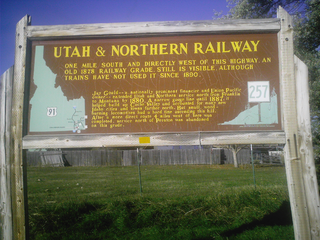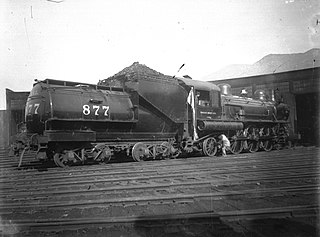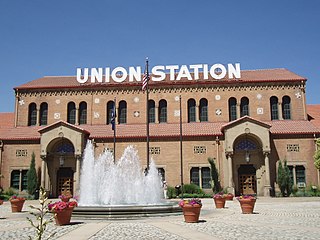
America's first transcontinental railroad was a 1,911-mile (3,075 km) continuous railroad line built between 1863 and 1869 that connected the existing eastern U.S. rail network at Council Bluffs, Iowa, with the Pacific coast at the Oakland Long Wharf on San Francisco Bay. The rail line was built by three private companies over public lands provided by extensive U.S. land grants. Building was financed by both state and U.S. government subsidy bonds as well as by company-issued mortgage bonds. The Western Pacific Railroad Company built 132 miles (212 km) of track from the road's western terminus at Alameda/Oakland to Sacramento, California. The Central Pacific Railroad Company of California (CPRR) constructed 690 miles (1,110 km) east from Sacramento to Promontory Summit, Utah Territory. The Union Pacific Railroad (UPRR) built 1,085 miles (1,746 km) from the road's eastern terminus at the Missouri River settlements of Council Bluffs and Omaha, Nebraska, westward to Promontory Summit.

The Denver and Rio Grande Western Railroad, often shortened to Rio Grande, D&RG or D&RGW, formerly the Denver & Rio Grande Railroad, was an American Class I railroad company. The railroad started as a 3 ft narrow-gauge line running south from Denver, Colorado, in 1870. It served mainly as a transcontinental bridge line between Denver and Salt Lake City, Utah. The Rio Grande was also a major origin of coal and mineral traffic.

A transcontinental railroad or transcontinental railway is contiguous railroad trackage, that crosses a continental land mass and has terminals at different oceans or continental borders. Such networks can be via the tracks of either a single railroad or over those owned or controlled by multiple railway companies along a continuous route. Although Europe is crisscrossed by railways, the railroads within Europe are usually not considered transcontinental, with the possible exception of the historic Orient Express. Transcontinental railroads helped open up unpopulated interior regions of continents to exploration and settlement that would not otherwise have been feasible. In many cases they also formed the backbones of cross-country passenger and freight transportation networks. Many of them continue to have an important role in freight transportation and some like the Trans-Siberian Railway even have passenger trains going from one end to the other.

Corinne is a city in Box Elder County, Utah, United States. The population was 809 at the 2020 census, up from the 2010 figure of 685.

The Union Pacific Railroad is a Class I freight-hauling railroad that operates 8,300 locomotives over 32,200 miles (51,800 km) routes in 23 U.S. states west of Chicago and New Orleans. Union Pacific is the second largest railroad in the United States after BNSF, with which it shares a duopoly on transcontinental freight rail lines in the Western, Midwestern and West South Central United States.

Promontory is an area of high ground in Box Elder County, Utah, United States, 32 mi (51 km) west of Brigham City and 66 mi (106 km) northwest of Salt Lake City. Rising to an elevation of 4,902 feet (1,494 m) above sea level, it lies to the north of the Promontory Mountains and the Great Salt Lake. It is notable as the location of Promontory Summit, where the First transcontinental railroad from Sacramento to Omaha in the United States was officially completed on May 10, 1869. The location is sometimes confused with Promontory Point, a location further south along the southern tip of the Promontory Mountains. Both locations are significant to the Overland Route; Promontory Summit is where the original, abandoned alignment crossed the Promontory Mountains while the modern alignment, called the Lucin Cutoff, crosses the mountains at Promontory Point.

The golden spike is the ceremonial 17.6-karat gold final spike driven by Leland Stanford to join the rails of the first transcontinental railroad across the United States connecting the Central Pacific Railroad from Sacramento and the Union Pacific Railroad from Omaha on May 10, 1869, at Promontory Summit, Utah Territory. The term last spike has been used to refer to one driven at the usually ceremonial completion of any new railroad construction projects, particularly those in which construction is undertaken from two disparate origins towards a common meeting point. The spike is now displayed in the Cantor Arts Center at Stanford University.

The Utah & Northern Railway is a defunct railroad that was operated in the Utah Territory and later in the Idaho Territory and Montana Territory in the western United States during the 1870s and 1880s. It was the first railroad in Idaho and in Montana. The line was acquired by a Union Pacific Railroad subsidiary, the Oregon Short Line, and is today operated by the Union Pacific Railroad as the Ogden Subdivision, part of the Pocatello Subdivision, and the Montana Subdivision.

The Oregon Short Line Railroad was a railroad in Wyoming, Idaho, Utah, Montana and Oregon in the United States. The line was organized as the Oregon Short Line Railway in 1881 as a subsidiary of the Union Pacific Railway. The Union Pacific intended the line to be the shortest route from Wyoming to Oregon and the Pacific Northwest. Construction was begun in 1881 at Granger, Wyoming, and completed in 1884 at Huntington, Oregon. In 1889 the line merged with the Utah & Northern Railway and a handful of smaller railroads to become the Oregon Short Line and Utah Northern Railway. Following the bankruptcy of Union Pacific in 1897, the line was taken into receivership and reorganized as the Oregon Short Line Railroad (“OSL”). The OSL became a part of the Union Pacific System in the Harriman reorganization of 1898.
The Salt Lake City Southern Railroad is a 25-mile (40 km) short-line railroad operating between Salt Lake City, and Murray, in Utah, United States. The SL began operating on April 19, 1993, as a RailTex subsidiary. Today the SL is a subsidiary of the Utah Railway and is owned by the Genesee & Wyoming Inc.

Union Station, also known as Ogden Union Station, is a train station in Ogden, Utah, United States, at the west end of Historic 25th Street, just south of the Ogden Central Station. Formerly the junction of the Union Pacific(UP) and Central Pacific (CP) railroads, its name reflects the common appellation of train stations whose tracks and facilities are shared by railway companies.

Union Pacific No. 119 was a 4-4-0 American type steam locomotive made famous for meeting the Central Pacific Railroad's Jupiter at Promontory Summit, Utah, during the Golden Spike ceremony commemorating the completion of the First transcontinental railroad in 1869. The locomotive was built by Rogers Locomotive and Machine Works of Paterson, New Jersey in 1868, along with numbers 116, 117, 118 and 120. The original was scrapped in 1903, but a replica now operates at the Golden Spike National Historical Park.

The Utah Division of the former Denver & Rio Grande Western Railroad (D&RGW) is a rail line that connects Grand Junction, Colorado and Salt Lake City, Utah in the Western United States. It is now incorporated into the Union Pacific Railroad (UP) system as part of the Central Corridor. The modern Union Pacific has split the line into two subdivisions for operational purposes, the Green River Subdivision between Grand Junction and Helper, Utah and the Provo Subdivision from Helper to Salt Lake City. Daily passenger service is provided by Amtrak's California Zephyr; the BNSF Railway and Utah Railway have trackage rights over the line.
The Lynndyl Subdivision is a rail line owned and operated by the Union Pacific Railroad in the U.S. state of Utah, running from Salt Lake City southwest to Milford, where the Caliente Subdivision continues towards Los Angeles. It was formerly part of the Los Angeles and Salt Lake Railroad and a section currently forms a segment of Union Pacific's Central Corridor. The subdivision is named for Lynndyl, a small community along the rail line. The highest elevation attained on the line is 6,061 feet (1,847 m) at Tintic. As of 2003 the line sees 16 trains daily between Lynndyl and Smelter.
Grass Creek is a ghost town in Summit County, Utah, United States. Lying some 8 miles (13 km) northeast of Coalville, it was once an important coal mining town. Grass Creek was inhabited circa 1860–1940.
The Utah Southern Railroad was built by members of the church of Jesus Christ of Latter Day Saints in 1871-2 to connect Salt Lake City to points south. The line was acquired by the Union Pacific Railroad (UP) in 1875. The Utah Southern Railroad name was initially kept as a separate division of the UP, but over time the line was moved around and divided among different UP subsidiaries. While most of the corridor is still used today it is no longer contiguous. The southern portion of the line, from Provo to Lynndyl, remains under UP ownership and is today known as the Sharp Subdivision. The portion through the Salt Lake Valley is today owned by the Utah Transit Authority and used for the TRAX light rail system, primarily the Blue Line. The portion between the end of the Blue line and Provo has had the rails removed, however UTA has retained the right to extend the TRAX system to Provo along the former Utah Southern right of way.

John Sharp was a 19th-century leader in the Church of Jesus Christ of Latter-day Saints in Utah Territory. Sharp was the LDS Church's representative in negotiations regarding the construction of the First transcontinental railroad through Utah Territory. He represented the LDS Church and its president, Brigham Young, at the driving of the final golden spike of the railroad on 10 May 1869 at Promontory Summit, Utah Territory.
The Deseret Telegraph Company was a telegraphy company headquartered in Salt Lake City, Utah, United States. The company was organized in 1867 to direct operation of the recently completed Deseret Telegraph Line; its largest stakeholder was the Church of Jesus Christ of Latter-day Saints. The Deseret line ran north and south through the Utah Territory, connecting the numerous settlements with Salt Lake City and the First Transcontinental Telegraph. The company was dissolved in 1900 when its assets, including the Deseret line, were sold to the Western Union Telegraph Company.

The history of the Union Pacific Railroad stretches from 1862 to the present. For operations of the current railroad, see Union Pacific Railroad; for the holding company that owns the current railroad, see Union Pacific Corporation.













